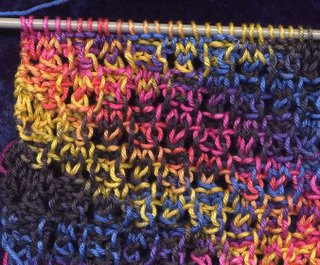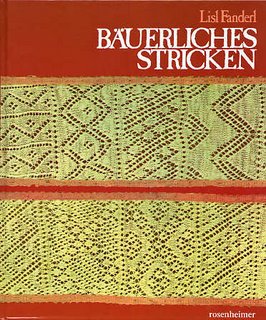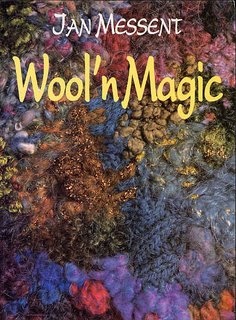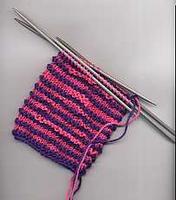As I said, this pattern is ideal for beginners and impatient people. You don't have to have a clear picture of where to go. You can let the sweater grow and change the pattern as you go along. You can even work around accidents.
Things you must be able to doIn the very basic form, just know how to knit and know how to increase. The most basic method is ok, even if it gives holes, because the holes will look like decoration. If you don't know how to work circular, some sewing will be required, especially if you don't want a cardigan, but a sweater. Just follow the
easy tag. If you are comfortable knitting circular, you can avoid sewing altogother, you still only have to knit garther stich, follow the
basic tag. If you are a experienced knitter I will post some variations look at the
variations tag.
Stuff you need :1) Yarn for easy and basic -> TouchDon't try to start with something fancy, do not use mohair, angora or anything very hairy. It has the tendency to stick and you cannot correct, because the hairy part breaks, if the yarn is unraveled. And if your hands are only slightly sweaty, it will make knitting harder. Do not use something with too much lurex, because it will sandpaper away your fingers. Do not use cheap acrylics. My motto is : a handknitted sweater is a luxury item. It never will be cheap, because you needed ages to finish it, don't make your hard work cheap, by using cheap yarn. I don't say anything against the new modern microfibre, but I talk about really cheap plastic yarn.
-> CostsIn Germany (and as far as I have seen in the US and the UK too) the yarn for a normal size sweater will be around 30 - 40 €/$, if you are lucky you can get decent yarn at a sale for less. You can spend a lot more, but if this is your first major work, do not spend more than a 100 €/$ in yarn.
-> RecommendationsUse Cotton, soft wool (there is hard wool too, if it feels like wire, thats not the right one), if you want to have some luxury, use alpaca, which is a dream to knit. Do not use handspun wool, except you trust the person making the stuff. If you can talk to this person and she/he can show you a sweater made with the yarn, you want to buy, its ok. But if the person who made that yarn, isn't good at it, there may be problems, you don't need for your first big work. Things like uneven thickness or places where the yarn is not spun properly and breaks. Too much alien material, like twigs and moss, which is bad for your skin. I have experienced all of this, so don't flame me. I know there are people who make wonderful handspun yarn, but there are also others. And for the first project you should go the easy route.
-> Gauge (yarn thickness)Needle size should be around 6-8 mm, don't go below 5mm and not over 9mm (You can find conversion charts
here, but I am used to the metric system :-)). If the yarn is too thin you need lots of stiches and the probability you will finish, goes way down. If the yarn is too thick it will be unwielding and too heavy to hold. You will have too few stiches and no room to manouver, because 1 wrong stich will be 1 cm, which shows. If you have a middle size you should need around 500-600g of yarn, if you need more than 1 kg of yarn, don't use it. The sweater will be too heavy and break your arms, remember you will have to lift it during work.
-> How much yarnIf you are middle size you are lucky, you can trust the stuff written on the yarn, if you are unsure, ask the person who sells it. Take rather more than less and ask if you may bring unused yarn back. Don't panic, if you later find out, that you don't have enough yarn, I will tell you, how to fix that. But rather buy more than less. I usually buy around 10-12 50g balls, the dummy in the photos has my size and I am 1.65 m tall, i.e. European and American average.
-> Important !Use yarn you really like. Use yarn you don't want to leave your hand ever. Use yarn you want to cuddle and take to bed. Never use yarn you don't like the color or the touch. At the store fumble it, touch it, play with it, arrange it in rows to see how the color looks, look at the color in daylight and don't be ashamed to use hours to find the right one. You will invest lots and lots of work in this yarn, be sure you like it. And be sure the color suits the person who will wear the sweater, probably you.
2) Needles :
-> For lazy people (me) and people following the easy track
I usually use one pair of circular knitting needles with a length of 60 cm. Thats why all my sweaters have a opening at the top. See the black sweater with the buttons and the tshirt. I have also made sweaters with the opening in the raglan part (which I don't have anymore). Even if you don't plan to knit circular, use the circular needles, the weight of the sweater will rest in your lap and not on your arms, which is very, very important.
-> For perfectionists
If you can start with 40 cm (see measurement later) you can use the small circular needles, they don't come much shorter in a decent gauge. Or you can use double pointed needles. And you will need a 60 cm circular needle. What with starting one gauge smaller, tried it, don't think it necessary, you can do it if you like.
-> For large people
If you have a circumference of more than 90 cm you will probably also need a circular needle with 80 cm length to knit comfortable. Never underestimate comfort.
-> What needle material
If you don't really have to have bamboo or wood I recomend steel. Easier for the beginner, nearly unbreakable, no hassle. Bamboo and wood tend to chip at the most inconvenient moment.
Measurements :
-> With a flexible meter and a mirror
Stand befor the mirror in a rather tight fitting garment and put the meter, where your sweater should start, take the size. Thats it.
-> With a string
Take a liberal amount of string, put it around your neck where the sweater should start, make a knot, measure it, finished !
Swatch :
-> Very lazy persons
Look at the yarn, there is a standard measurement swatch size printed somewhere on it, take this. Take your neck measurement divide by length given multiply by stiches given presto number of stitches you need, give some stiches extra, its easy to make the neck smaller afterwards, but very hard to make it larger.
-> Default way
Make a swatch with the same needles you plan to use. Take 12-14 or 22-24 stiches and knit at least 8 rows, better to make the swatch quadratic (if you fold it diagonally base row to side, the corners match, no measurement required ;-)). if you want to be a perfectionist you can wash the swatch and block it (if you don't know what I am talking about google it, there are lots of basic knitting sites available). If you feel that all this hassle stops you from ever starting, use the first way or skip the washing and blocking. The pattern is pretty forgiving. Lay the swatch flat on the table, take the 10 or 20 stiches in the middle, without the edge stiches and measure them. The next step is the same as above your start number of stiches is (neck measurement) times (stitches measured in the swatch) divided by (length of the stiches measured).
Thats all, ready to start.











